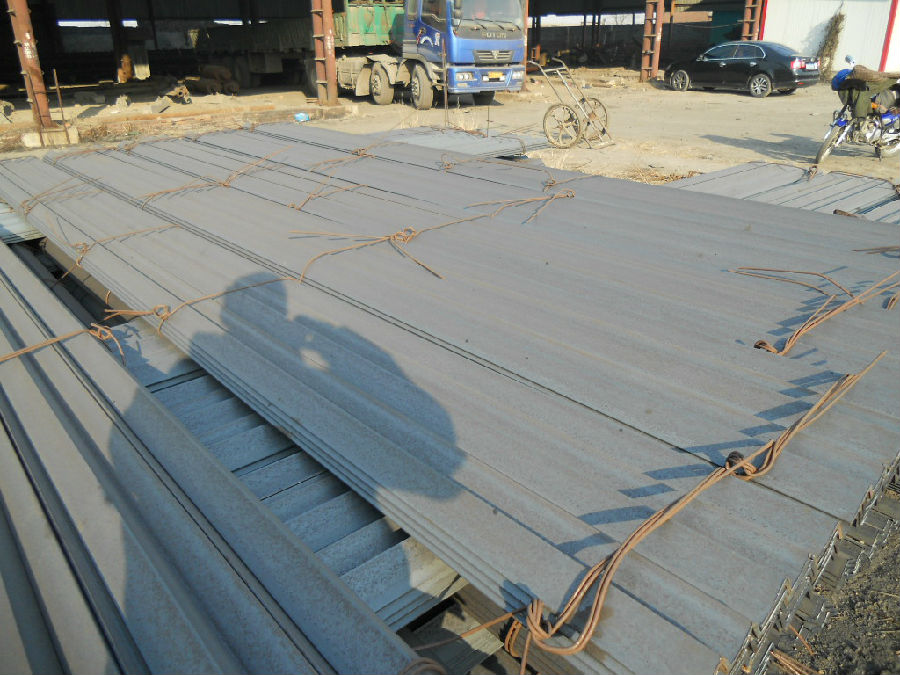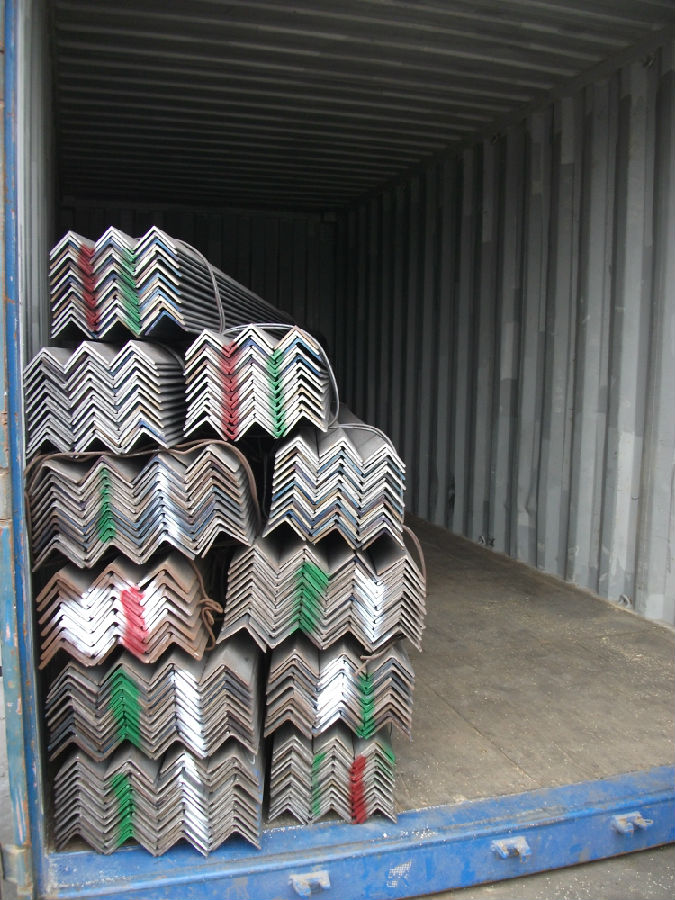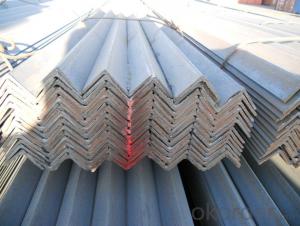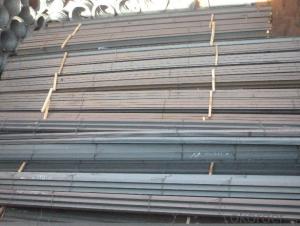angle bar equal angle steel angle steel bar angel steel
- Loading Port:
- Tianjin
- Payment Terms:
- TT OR LC
- Min Order Qty:
- 20 m.t.
- Supply Capability:
- 20000 m.t./month
OKorder Service Pledge
OKorder Financial Service
You Might Also Like
Specifications
Hot Rolled Equal/Unequal Q195-345 Angel Steel
1. High Strength;
2. Hot Rolled Technique;
3. Any quantity is available.
Working Today, Building Tomorrow!
We do care:
--Good Quality
--On-time Delivery
--Competitive Price
--Efficient After Service
galvanized angle steel ! ! ! equal angle steel angle steel bar angel steel
Products Details:
1.Standard: AISI ASTM BS DIN GB JIS
2.Dimensions:10*10mm-200*200mm
3.Grade:Q195-Q420 Series
4.Place of Origin:Tianjin,China
5.Length:6m 9m 12m or as per request
6.Application:Building structure and engineering structure, such as the beam, Bridges, transmission tower,
lifting transportation machinery, ship, industrial furnace, reaction tower, container frame and warehouse.
7.Technology:Hot Rolled / Cold Rolled
8.Packaging Detail: Mills standard export strong packing
9.Price Term:FOB/CFR/CIF,According to clients requirements
10.Delivery Datail:7-10 Workdays after deposit
11.MOQ:25MT
12.Payment:T/T or LC
13.12.Authentication:ISO9001-2008,SGS.BV
Products Material:
Q195-Q420 Series
SS400-SS540 Series
S235JR-S355JR Series
ST Series
A36-A992 Series
Gr50 Series



- Q: Can steel angles be used for manufacturing balcony structures?
- Yes, steel angles can be used for manufacturing balcony structures. Steel angles are commonly used in construction due to their strength and durability. They provide structural support and stability, making them suitable for balcony structures. Steel angles are often used as support beams or framing components in balcony construction, providing a solid base for the balcony's flooring and railing. Additionally, steel angles can be easily fabricated and customized to meet specific design requirements, making them a versatile choice for balcony manufacturing.
- Q: Can steel angles be used in the construction of pedestrian bridges?
- Indeed, the utilization of steel angles is feasible in the construction of pedestrian bridges. Owing to their robustness and longevity, steel angles are widely employed in construction. They serve the purpose of offering structural support and stability to pedestrian bridges, while also enabling the creation of frames, beams, and trusses. The adaptability in design and construction is facilitated by the ease of welding or bolting steel angles together. Moreover, steel angles can be galvanized or coated, amplifying their resistance to corrosion and rendering them suitable for outdoor applications like pedestrian bridges. All in all, steel angles emerge as a versatile and dependable option for the construction of pedestrian bridges.
- Q: What are the guidelines for designing connections using steel angles?
- The guidelines for designing connections using steel angles typically involve determining the appropriate angle size, thickness, and length based on the loads and forces that will be applied to the connection. Additionally, considerations such as the type of welds or bolts to be used, the spacing and arrangement of the angles, and any applicable design codes or standards must be taken into account. It is important to ensure that the connection is structurally sound and provides adequate strength and stability for the intended application.
- Q: Can steel angles be used in mining or quarrying machinery?
- Steel angles are indeed applicable in mining or quarrying machinery. They offer structural support and reinforcement to different machinery components used in these sectors. Frames, supports, and brackets for equipment like crushers, conveyors, and screens are often constructed using steel angles. Due to their high strength and durability, steel angles can withstand the heavy loads, vibrations, and harsh operating conditions commonly experienced in mining or quarrying operations. Moreover, steel angles can be easily fabricated and welded to meet specific design needs, making them a flexible option for machinery applications in these industries.
- Q: How do steel angles perform under vibration or resonance conditions?
- Steel angles are widely recognized for their exceptional structural properties, specifically their ability to endure vibrations and resonance circumstances. In the presence of vibrations, steel angles demonstrate impressive stiffness and damping characteristics, allowing them to proficiently dissipate the energy generated by these vibrations. This behavior is a result of the inherent material properties of steel, including its substantial strength and rigidity. Additionally, steel angles exhibit commendable performance under resonance conditions. Resonance arises when the frequency of external excitation matches the natural frequency of the steel angle. In such instances, the steel angle may encounter amplified vibrations that could potentially lead to structural failure if not adequately addressed. Nevertheless, steel angles are meticulously designed and fabricated with resonance considerations in mind, guaranteeing their capacity to withstand and alleviate the repercussions of resonance. To further enhance the performance of steel angles under vibration or resonance conditions, engineers can employ an array of techniques. These techniques encompass the incorporation of damping materials or devices to absorb or dissipate vibrational energy, the alteration of the geometric properties of the steel angle to modify its natural frequency, and the utilization of vibration isolation systems to minimize the transmission of vibrations to the steel angle. In conclusion, steel angles are exceptionally suitable for applications that require resistance to vibrations or resonance conditions. Their remarkable strength, stiffness, and damping properties enable them to effectively withstand and mitigate the effects of vibrations, thereby ensuring the integrity and stability of the structure in which they are employed.
- Q: Can steel angles be used in high-temperature applications?
- Depending on the alloy and temperature range, steel angles can be utilized in high-temperature scenarios. Stainless steels and heat-resistant alloys, which are specifically engineered for high-temperature applications, possess the ability to endure elevated temperatures without compromising strength or structural integrity. These alloys typically contain elements such as chromium, nickel, or molybdenum, which enhance resistance against corrosion, oxidation, and high temperatures. Nonetheless, it is imperative to acknowledge that not all steel angles are appropriate for high-temperature uses. Ordinary carbon steels, for instance, have a restricted temperature range before experiencing strength loss and becoming vulnerable to deformation or failure. The precise temperature threshold for a specific steel angle relies on factors such as alloy composition, heat treatment, and duration of exposure to high temperatures. To recap, steel angles can be employed in high-temperature applications if they are constructed from suitable alloys specifically designed for such conditions. It is essential to consult materials engineers or experts who can provide guidance on appropriate steel alloys and temperature limits for a given application to ensure performance that is safe and reliable.
- Q: What is the maximum deflection for a steel angle beam?
- The maximum deflection for a steel angle beam depends on various factors such as the span length, load applied, and the properties of the steel angle beam itself. To determine the maximum deflection, one must consider the beam's moment of inertia, elastic modulus, and the applied load. By using appropriate formulas and calculations, engineers can determine the precise maximum deflection for a steel angle beam in a given scenario. It is important to note that the maximum deflection should always be within acceptable limits to ensure the structural integrity and safety of the beam.
- Q: What is the carbon content of steel angles?
- The carbon content of steel angles may differ based on the particular grade and type of steel employed. Typically, carbon steel angles possess a carbon content that spans from 0.05% to 0.25%. Nevertheless, certain high carbon steel angles can exhibit a carbon content reaching up to 2.1%. The carbon content of steel angles holds significant importance, as it impacts the strength, hardness, and overall characteristics of the steel.
- Q: What is the process of hot rolling steel angles?
- The process of hot rolling steel angles involves a series of steps that transform raw materials into finished steel angles with specific dimensions and properties. Firstly, the raw material, which is typically a billet or a continuous casting, is heated to a temperature above its recrystallization point. This makes the steel more malleable and easier to shape. The heated billet is then fed into a rolling mill, where it passes through a series of rollers. These rollers apply pressure to the billet, causing it to deform and take the shape of an angle. The angle is determined by the shape of the rollers, which have a groove or profile that matches the desired angle dimensions. As the billet passes through the rolling mill, it undergoes a process called plastic deformation. This involves the elongation and reduction of its cross-sectional area, resulting in a longer and thinner shape. The angle's flanges, which are the vertical sides, and the web, which is the horizontal section connecting the flanges, are formed during this deformation. To maintain the desired shape and dimensions, the steel angle may pass through multiple sets of rollers, each applying pressure and further shaping the angle. This continuous rolling process ensures consistent dimensions and smooth surfaces. Once the hot rolling process is complete, the steel angles are cooled and straightened. This is typically done using water or air cooling methods. Cooling the steel rapidly helps to harden and strengthen it, while straightening ensures that the angles are free from any bends or twists. After cooling and straightening, the steel angles may undergo additional processes such as cutting to the desired length, surface treatment such as painting or galvanizing, and quality control inspections to ensure they meet the required specifications. Overall, the hot rolling process for steel angles involves heating the raw material, passing it through rolling mills to shape and deform it, cooling and straightening the angles, and finally finishing them to meet the desired specifications. This process results in high-quality steel angles that are widely used in construction, manufacturing, and various other industries.
- Q: What are the different grades of steel used in angle production?
- Angle production commonly utilizes various grades of steel, each chosen based on the intended application and the required strength and durability. Some frequently used grades for angle production are as follows: 1. A36 steel, a versatile choice for angle production, is a low carbon steel commonly employed in general construction and engineering applications due to its good strength, weldability, and machinability. 2. A572 steel, a high-strength, low-alloy steel, is often utilized in structural applications, including bridges, buildings, and heavy machinery. Its excellent strength and toughness make it suitable for angles subjected to heavy loads and extreme conditions. 3. A588 steel, a weathering steel, forms a protective rust-like coating when exposed to the elements. It finds common usage in outdoor structures like bridges, buildings, and sculptures. A588 steel angles offer corrosion resistance, strength, and durability. 4. A500 steel, a cold-formed, welded carbon steel, is commonly used in structural applications such as frames, supports, and braces. It comes in different grades, including A, B, and C, each with varying strength levels. A500 steel angles are prevalent in construction projects requiring high strength and stability. 5. Stainless steel, an alloy containing at least 10.5% chromium, boasts corrosion resistance and finds application in environments exposed to corrosion, heat, and chemicals. Stainless steel angles are extensively used in industries like food processing, chemical processing, and marine environments. These examples highlight the variety of steel grades utilized in angle production. The appropriate grade selection depends on factors such as the intended application, desired strength and durability, and environmental conditions. Consulting with a steel expert or engineer is crucial to determine the most suitable grade for a specific angle production project.
Send your message to us
angle bar equal angle steel angle steel bar angel steel
- Loading Port:
- Tianjin
- Payment Terms:
- TT OR LC
- Min Order Qty:
- 20 m.t.
- Supply Capability:
- 20000 m.t./month
OKorder Service Pledge
OKorder Financial Service
Similar products
Hot products
Hot Searches
Related keywords




























